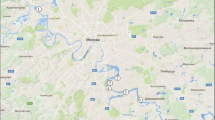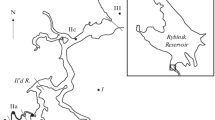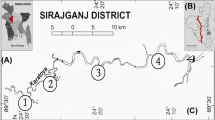Abstract
The changes in the ratio of species representing different morpho-functional groups, identified by physiological, morphological and ecological parameters [29] were analyzed based on the study on phytoplankton in different reaches of the Rybinsk Reservoir in 2000–2005. Water quality was assessed by the Q index of communities, developed taking into account the proportions of these groups. This assessment was compared with the evaluation using the values of Pantle–Buck saprobity index and phytoplankton biomass.


Similar content being viewed by others
REFERENCES
Volga i ee zhizn’ (The Volga and Its Life) Butorin, N.V., Mordukhai-Boltovskoy, F.D., Ed., Leningrad: Nauka, 1978.
Greze, B.S., On the plankton of Sheksna, Mologa and Sit’. Proc. Yaroslavl. Soc. Nat.-Hist. Region. Stud., 1928, vol. 4, no. 2, pp. 11–17.
Esyreva, V.I., Flora of algae of the Volga River from Rybinsk to Gorky. Tr. Bot. Sada MGU, 1945, no. 82, pp. 10–90.
Korneva, L.G., Succession of phytoplankton, in Ekologiya fitoplanktona Rybinskogo vodokhranilishcha (Ecology of Phytoplankton of the Rybinsk Reservoir): Tolyatti, 1999, pp. 89–148.
Korneva, L.G., Phytoplankton of the Rybinsk Reservoir: composition, features of distribution, consequences of eutrophication, in Sovremennoe sostoyanie ekosistemy Rybinskogo vodokhranilishcha (Modern State of the Rybinsk Reservoir Ecosystem), St. Petersburg: Gidrometeoizdat, 1993, pp. 50–113.
Korneva, L.G. and Solov’eva, V.V., Experience of use of morpho-functional classification of freshwater algae for assessment of dynamics and spatial distribution of phytoplankton of the Rybinsk Reservoir. Yaroslavskii Pedagogicheskii vestn., 2012, vol. 3, no. 3, pp. 110–114.
Korneva, L.G., Solov’eva, V.V., and Makarova, O.S., Raznoobrazie i dinamika planktonnykh al’gotsenozov vodokhranilishch Verkhnei i Srednei Volgi (Rybinskoe, Gor’kovskoe, Cheboksarskoe) v usloviyakh evtrofirovaniya i izmeneniya klimata, in Ekologiya, morfologiya i sistematika vodnykh rastenii (Diversity and Dynamics of Planktonic Algocenoses in the Upstream and Midstream Volga Reservoirs (Rybinsk, Gorky, Cheboksary) in the Conditions of Eutrophication), Yaroslavl: Filigran’, 2016, pp. 35–45.
Korneva, L.G., Solov’eva, V.V., Mitropol’skaya, I.V., et al., Phytoplankton communities of the upstream Volga reservoirs), in Ekologicheskie problemy Verkhnei Volgi (Ecological Problems of the Upper Volga), Yaroslavl: YaGTU, 2001, pp. 87–93.
Kuz’min, G.V., Okhapkin, A.G., and Il’inskii, A.L., Phytoplankton as indicator of saprobity of waters of the Glavny reach of the Rybinsk Reservoir, Biologiya Nizshikh organizmov. Tr. IBVV RAN, 1978, no. 40, pp. 36–52.
Levich, A.P. and Bulgakov, N.G., On the possibility of regulations of structure of laboratory algocenosis, Izv. Akad. Nauk, Ser. Biologicheskaya., 1993, no. 4, pp. 569–578.
Metodika izucheniya biogeotsenozov vnutrennikh vodoemov (Methods for Studies of Biogeocenoses of Inland Waters) Mordukhai-Boltovskii, F.D., Ed., Moscow: Nauka, 1975.
Mitropol’skaya, I.V., Struktura i dinamika fitoplanktona Rybinskogo vodokhranilishcha (Structure and dynamics of phytoplankton of the Rybinsk Reservoir), Extended Abstract of Cand. Sci. (Biol) Dissertation, Moscow: MGU, 2010.
Megarran, E., Ekologicheskoe raznoobrazie i ego izmerenie (Ecological Diversity and Its Measuring), Moscow: Mir, 1992.
Oksiyuk, O.P., Zhukinskii, V.N., Braginskii, L.P., et al., Combined ecological characteristics of quality of land surface waters, Gidrobiol. Zh., 1993, vol. 29, no. 4, pp. 62–77.
Rybinskoe vodokhranilishche i ego zhizn’ (The Rybinsk Reservoir and Its Life), Leningrad: Nauka, 1972, p. 364.
Solov’eva, V.V. and Korneva, L.G., Modern characteristics of saprobity of the Rybinsk Reservoir by phytoplankton, Voda: Khimiya i ekologiya, 2012, no. 5, pp. 18–23.
Stepanova, I.E., Bikbulatov, E.S., and Bikbulatova, E.M., Patterns of dynamics of content of nutrients in waters of the Rybinsk Reservoir during the years of its existence, Voda: Khimiya i ekologiya, 2013, no. 1, pp. 15–28.
Fortunatov, M.A., Color and transparency of waters of the Rybinsk Reservoir as indices of its regime, in Tr. In-ta biol. vodokhranilishch. M.; Leningrad: AN SSSR, 1959, issue 2(5), pp. 246–357.
Devercelli, M., Changes in phytoplankton morpho-functional groups induced by extreme hydroclimatic events in the middle Parana River (Argentina), Hydrobiologia, 2010, vol. 639, pp. 5–19.
Water, Policy., European Commission PE-CON, p. 3639.
Guildford, S.J. and Hecky, R.E., Total nitrogen, total phosphorus, and nutrient limitation in lakes and oceans: is there a common relationship?, Limnol. Oceanogr., 2000, vol. 45, no. (6), pp. 1213–1223.
James J. Elser, Matthew E.S. Bracken, Elsa E. Cleland, Daniel S. Gruner, W. Stanley Harpole, Helmut Hillebrand, Jacqueline T. Ngai, Eric W. Seabloom, Jonathan B. Shurin, and Jennifer E. Smith. Global analysis of nitrogen and phosphorus limitation of primary producers in freshwater, marine and terrestrial ecosystems, Ecol. Letters, 2007, vol. 10 P, pp. 1135–1142.
Kruk, C., Mazzeo, N., Lacerot, G., and Reynolds, C.S., Classification schemes for phytoplankton: a local validation of a functional approach to the analysis of species temporal replacement, J. Plankton Res., 2002, vol. 24, no. 9, pp. 901–912.
Marchetto, A., Mariani, M.A., Luglie, A., and Sechi, N., A numerical index for evaluating phytoplankton response to changes in nutrient levels in deep Mediterranean reservoirs, J. Limnol, 2009, vol. 68, no. 1, pp. 106–121.
Padisak, J., Borics, G., Grigorszky, I., and Soroczki-Pinter, E., Use of phytoplankton assemblages for monitoring ecological status of lakes within the water framework directive: the assemblage index, Hydrobiologia, 2006, vol. 553, pp. 1–14.
Padisak, J., Crossetti, L.O., and Naselli-Flores, L., Use and misuse in the application of the phytoplankton functional classifcation: a critical review with updates, Hydrobiologia, 2009, vol. 621, pp. 1–19.
Piirsoo, K., Pall, P., Tuvikene, A., Viik, M., and Vilbaste, S., Assessment of water quality in a large lowland river (Narva, Estonia/Russia) using a new Hungarian potamoplanktic method, Estonian J. Ecol, 2010, vol. 59, no. 4, pp. 243–258.
Redfield, A.C., On the proportion of organic derivatives in seawater and their relation to the composition of plankton, James Johnstone Memorial Volume. Liverpool: Univ. Press of Liverpool, 1934, pp. 176–192.
Reynolds, C.S., Huszar, V., Kruk, C., Naselli-Flores, L., and Melo, S., Towards a functional classification of the freshwater phytoplankton, J. Plankton Res., 2002, vol. 24, no. 5, pp. 417–428.
Schindler, D.W., Eutrophication and recovery in experimental lakes: implications for lake management, Science (Washington, D.C.), 1974, vol. 184, no. 4139, pp. 897–899.
Schindler, D.W., Fee, E.J., and Ruszcynski, T., Phosphorus input and its consequences for phytoplankton standing crop and production in the experimental lakes area and in similar lakes, J. Fish. Res. Board Can., 1978, vol. 35, pp. 190–196.
Sladecek, V., System of water quality from the biological point of view, Arch. Hydrobiol., 1973.
Smith, V.H., Low N to P favor dominance by blue-green algae in lake phytoplankton, Science (Washington, D.C.), 1983, vol. 221, pp. 669–671.
Suttle, C., Cochlan, W.P., and Stockner, J.G., Size-dependent ammonium and phosphate uptake, and n:p supply ratios in an oligotrophic lake, Can. J. Fish. and Aquat. Sci, 1991, vol. 48, pp. 1226–1234.
Vollenweider, R.A., Advances in defining critical loading levels of phosphorus in lake eutrophication, Mem. Inst. Ital. Idrobiol, 1976, vol. 33, pp. 53–83.
Vollenweider, R.A., Input-output models, Hydrol., 1975, vol. 37, pp. 53–84.
Wegl, R., Index fur die limnosaprobitat, Wasser und Abwasser, 1983, vol. 26, p. 175.
ACKNOWLEDGMENTS
We are sincerely grateful to the crews of expedition vessels of Papanin Institute of Biology of Inland Waters, Russian Academy of Sciences and to T.P. Zaykina for assistance in sampling.
Funding
The study was performed under State Task no. АААА-А18-118012690096-1 and was partially supported by the Russian Foundation for Basic Research (project no. 18-04-01069).
Author information
Authors and Affiliations
Corresponding author
Rights and permissions
About this article
Cite this article
Korneva, L.G., Solovyeva, V.V. Dynamics of Morphofuncitonal Groups of Phytoplankton in the Rybinsk Resrevoir and Assessment of the Resevoir Water Quality by the Community Index. Water Resour 48, 65–72 (2021). https://doi.org/10.1134/S0097807821010206
Received:
Revised:
Accepted:
Published:
Issue Date:
DOI: https://doi.org/10.1134/S0097807821010206




